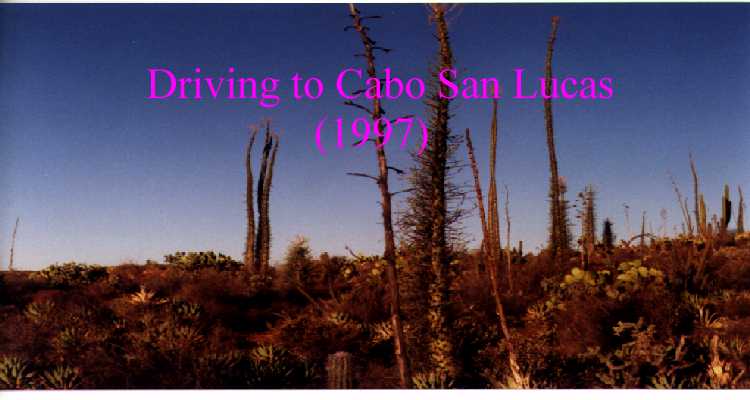 |
 |
Once past Ensenada the traffic thinned and we poked our way south through the hills and valleys. The vinyards in the valley of Santos Tomas looked healthy and pruned but the big winery had no welcome sign out. We were using Shirley's AAA book as a guide and, along about three o'clock as we started looking for a place to spend the night, turned off on the road it showed from Colonet to San Antonio del Mar. After six miles of VERY washboardy travel we arrived at a neat little community built on dunes right next to the ocean. Then I made a mistake: I tried to follow a four wheel drive vehicle up on a dune to what looked like a parking spot with a great view. Seconds later Henry was bogged down in soft sand. We'd still be there if some locals in a VW van which was also stuck in the sand for a while hadn't come over and helped push him out. We'll stick to hard surfaces in the future. We parked for the night in a nice level spot back behind the dunes...not as nice a view, but much less risky. Ate pastrami and artichokes for dinner. We're camping now.
At Rosario we filled our fuel tank...Pemex now has self serve stations...bought groceries, booze, and beer at the mercado, and then took another side trip out the 10 mile long gravel road to Punta Baja where we ate our lunch perched on the edge of a cliff overlooking the fishing village a bay and watched the Pacific ocean pounding on the rocks below. Neat place!
| South of Rosario Highway 1 enters real Sonoro desert country. The vegetation is unique and beautiful. There are whole forests of Cerio and Cardon mixed with dozens of other cacti. Right now, because of recent rains, many of the cactus are green and wild flowers are starting to bloom. We poked along, enjoying the scenery and stopping now and then to take pictures. About three, we came to what the books calls the Catavina bolder field, found a nice spot off the highway behind several of the huge granite bolders scattered over the desert, and parked for the night. Took a walk around...that's the neat thing about the desert, unlike a rain forest, you can walk between the plants. Just remember to stay clear of their weapons. In the evening the clouds which had been with us all day cleared away and a bright moon and stars came out. I think tomorrow we may start the new year with a real Baja day. | 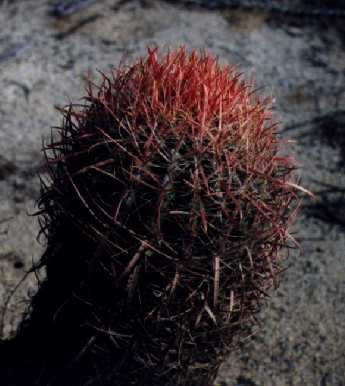
|
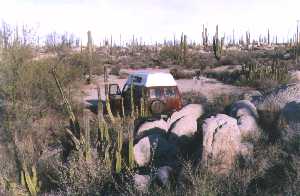
|
And a bright Baja morning it was as the sun rose over the giant Cardons and Cerios surrounding our parking place in the desert. We've seldom had a nicer place to camp. We ate a lazy breakfast as the sun warmed the cool night air, then packed up and rolled down the highway through some of the prettiest country to be seen anywhere. |
Then, about fifty miles south of Catavina, things suddenly changed. The large desert plants disappeared and nothing but low scrub covered the flat desert. For a hundred miles the desolate land stretched ouut in front of us. The one blessing was that sometime in the past ten years they have resurfaced the highway. This used to be the worst part of the transpeninsular highway, a place where the buses had to slow to a crawl. Now it's as good or better than any Baja road. Just past Guerrero Negro we took a side road to the Parque National at Scammon's Lagoon. It's a little early for the big blues to be calving, but I wanted to see what the famous lagoon looked like. The government has made a pretty nice park at the end of a road through the salt beds. They've carved out widely spaced camping sites along the edge of the lagoon where you can be near the water but not feel crowded by your neighbor. Pangas carry would be whale watchers out onto the lagoon...private vessels of any kind are not allowed. We parked in one of the campsites and ate lunch, but tonight we're due for a stay in a hotel and a bath. We found that on down the road 90 miles at San Ignacio, the location of one more of the La Pinta hotels. Nice room, two queen beds, large shower with hot water, air conditioning, and a TV. No telephone though, no way to connect on e-mail here. That will have to wait a while longer. We walked halfway to town then came back and got the van because we weren't sure how far it was. Should have kept going. Bought Lois a T-shirt...she didn't bring any light clothing and eighty degrees is now the norm. Had dinner at the hotel...edible and expensive but that's about all I can say for it. San Ignacio is sure a pretty town. You cross a a bridge over a large pond as you enter and there are big date palms everywhere. It's a real oasis after the lonng desert drive.
| On down the road at Bahia Concepcion most of the camping sites along the bay are filled with RVs. Santispec and Coyote are jammed with people and we aren't yet to the peak season. We kept rolling and midway between Mulege and Loreto turned off onto a gravel road which the AAA book says leads to San Isidro and Purisma. We followed it's ups and downs for 30 miles through deep canyons and high ridges before coming on those two little oasis towns. Only five miles apart, they both lie in valleys filled with date trees and flowers, including some of the biggest and brightest Bogenvillas(sp) I've seen anywhere. | 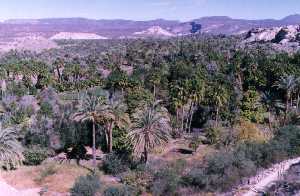
|
Our gravel road joined paved highway at San Isidro a fact for which we were grateful after our bouncy, hour and a half ride. We'd both been prepared for another three or four hours of rough road, but soon after leaving Purismo the now well paved road climbed to a flat plane stretching for mile after mile to the south. At times we could see the Pacific far off to the west as we followed the arrow straight highway toward Ciudad Insurgentes where it joins Highway 1. Ten miles father on, at Ciudad Constitucion we turned right again toward San Carlos. That's where we spent the night. We found a neat place to park right on the edge of Bahia Magdelana not far from where we'd anchored on our first visit in 1988. Watched the sun set over the bay while the shore birds gathered their dinner just feet from our door. Very pretty place.
Discovered that we have a leak from our water tank...got to check that out in the morning.
That was pretty much the story of our day. We spent the night at the Casa Blanca Trailer Court, a pretty nice place as trailer courts go. Level parking places with trees all around, full hookups, potable water, showers, tennis court, and pool. The showers even had hot water in the morning. $13.50 for the works.
Got to Cabo about noon, ate lunch at a taco stand, wondered at the number of new hotels that have been, and are being, built where there were only little shops in 1988, and had a margarita at Carlos & Charley's, one of the few old timers still here. The city was crowded today, far too many people for our tastes, so we soon headed on, this time northbound on Highway 1. Turned off on the Ribera junction and follow the side road south to Los Frailes which we remembered as a neat place where a few windsurfers had camped. We were shocked to find it crowded with people and RVs, again way too many people for us to be comfortable. The road is paved about half way and had been recently graded to within a couple of miles of Los Frailes so it was pretty easy driving. Part way back, just south of Cabo Pulmo we found a spot where we could park on the edge of a cliff overlooking the sea with only a handful of other campers nearby. Had a nice evening there enjoying the breeze while watching the pelicans diving for fish.
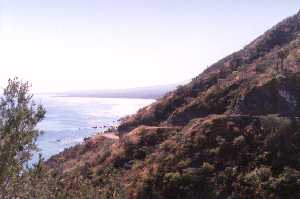
|
North of Cardonel the road narrows, and beyond Boca del Alamo becomes one lane and winding as the mountains of Sierra de Laguna crowd down toward the sea. It would still be passable by ordinary cars, though, until it turns inland. There it climbs through a stream bed and over rocks which would give a low clearance vehicle trouble. Old Henry handled it well though, only slipping his tires a couple of times on extra steep humps. Not much traffic on this route. |
We took another side trip on the way back to La Paz, out to La Ventana where we ate a lunch of fish tacos at a tiny stand by the side of the road. There's another popular camping beach at Ventana with dozens of RVs stacked on top of each other. They give the impression of Gypsy camps. We got to La Paz about 14:00 and drove straight through, stopping only to buy pesos at one of the "Permanente" cash machines. It was only five years ago that I was wondering at how "easy" getting money had become here in Mexico...I'd only had to wait in ONE line for less than half an hour. Now it takes seconds.
From La Paz we drove out past Pichelinque to Balandra where we'd anchored when we first arrived in February of '88. It's one of the prettiest bays we've every been in. This Sunday afternoon there were many picnicers enjoying its shores. We got out and stretched our legs a bit walking the hard sand beach, then went on to Tecolote on the north shore of the peninsula where we camped for the night. Tecolote is a busy place with a few jet skis buzzing about and someone giving rides in an ultralight aircraft. There were quite a few people there when we arrived, but they soon started leaving as the sun sank in the west. Nice night with a cool breeze and sound of the sea on the shore.
Got back to town about noon, did a little shopping, and had lunch at the Feliz Cameroni. Pretty good fraitos and ceviche. Then it was time to go to work. We checked in again to the Casa Blanca Trailer Court and went to work cleaning Henry. After all the dusty roads we've been on, he was in need of attention. I washed him down outside while Lois worked on the interior. He's looking pretty good now. We found that there is a lady at the laundromat who does the wash for you, so we took all our dirty stuff to her. Cost 65 pesos for three big loads, washed, dried and folded. Good deal for us. We both took showers and I also dumped the potty and got it squeeky clean. We're ready for another week of travel.
Tried to call Nan this evening from one of the "Just Dial O" phones here at the trailer court. No dice. The international operator says my calling card number is no good; and she couldn't connect me with an AT&T operator. Said I had to go to a Lada phone for that.
Discovered another small problem during the night, one with a tail. WE HAVE A MOUSE! I caught a glimpse of him scurrying across our box of dry foods in the back of the van and later heard him nibbling away at something. When I tried to turn on the light to see where he was, it wouldn't come on...our house battery was dead. Soooo...I had to get up, dig out our power cord, and plug us in. That got the lights and frige going again. In the morning I'll see if I can discover why the battery got run down. It's been holding up really well until now.
Got away from the trailer court about 07:30 and had an excellent machaca breakfast at Loncheria Km 113, a clean little cafe next to the highway at, you guessed it, kilometer post 113. Stayed on Highway 1 back through Ciudads Constitucion and Insurgentes. Gassed up there and headed for Lorato. We never been on the road south of Lorato so it was new to us. As soon as you get into the mountains it becomes a very pretty drive. The wind and rain have carved fantastic shapes in those big piles of rock and sandstone. I had forgotten just how spectacular the mountains are behind Puerto Escondido. Puerto Escondido has sure changed. Nothing but the concrete and a few leaning light poles remains of the big development planned for that place. Moorings is gone, the port captain's office is gone, the military building stands deserted. The only thing left are the cruising...and liveaboard...boats in the landlocked bay. A dozen or so of them remain. In Loreto we bought some oranges and a melon, then drove around for a while though the narrow streets. Not much has changed there. I think I found Gustave's house but we didn't stop...it's been too many years and land cruising is a different world.
Our AAA road map and guide book show a road leading to the San Juanico fish camp about thirty miles north of Lorato. I thought that would be a neat place to go for the night...San Juanico was one of our favorite anchorages. We found the road all right, and followed it over rocks and through washes for an hour before coming to its end, not at San Juanico, but on the beach well north of the bay we liked so much. There were four campers there. I talked to a couple of them who told me that we should have turned right at the "goat camp". We went back and looked at the fork in the road they said led to a bay with pinnacle rocks and decided that it looked a little too much for Henry. He does good, but he ain't no 4X4. Just as well, if the road there were decent the place would be overrun with RVs.
Another hour back to the highway, then it was on to Bahia Concepcion where we found a nice spot off the highway on the edge of the bay where we could park old Henry on a pile of scollop shells. After the sun went down and it got dark, Lois fixed a salad for dinner. As we were eating, our mouse, who had evidently gotten a whiff of the Parmesan cheese she had put on the salads, came out of hiding and sat nibbling a bit on the floor. Lois 'bout had a fit! He was a cute little guy, about two inches long with big brown eyes and a twitching nose. I figured his name mst be Herman. He looked well fed, but he was sure hungry this evening. I don't think he'd managed to get into any of our foodstuffs. We watched him for a while, trying to figure out how to get him out of the van, then Lois came up with an idea. She sprinkled a little grated Parmesan on the carpet near the door and, when he went for it, the two of us herded him out and slammed the door. Poor Herman had to spend the night out in the cold. We still can't guess how he got aboard in the first place, but we heard no more of him tonight.
In Santa Rosalia we carefully avoided the Pemex station. Bought groceries at the little fruiteria up on the hill and bolellos from the "world famous bakery" in the center of town. Oh, those fresh bolellos are tasty! Climbed up the long steep hill out of Santa Rosalia and rolled past the Tres Virgines, three towering volcanos between the coast and San Ignacio. There's a geothermal power facility near one of them. Gassed up in San Ignacio and drove through the town again. It's a pretty spot in an otherwise desolate desert, with all its date palms and its pretty little lake. At San Vizcaino we turned left and ran for a few miles to the end of the blacktop, with the idea of possibly going all the way to Bahia Tortugas. The AAA book says that the road is "built to highway standards" but unpaved. Well, the unpaved section we hit had the worst washboarding yet. We decided that old Henry wouldn't be happy with 90 miles of that, so it was back to the blacktop as soon as we could get turned around. San Vizcaino is an interesting village with orchards of neatly pruned fig trees lining the road, something we've not seen before.
We considered spending the night at Scammon's Lagoon but instead opted for a similar place a few miles north of Guerrero Negro, Laguna Manuella. It's a fish camp rather than a park, right on the edge of a bay called Puerto de Santo Domingo. There we parked on the hard sand beach and watched the sun go down over the headland to the west. I wonder why we chose to make an overnight run and bypass this place when we were on the boat. According to our charts it would have made a good anchorage??????
| We just poked along today, enjoying he scenery. This part of the desert is a lot more interesting than that down south, more ups and downs, more different shapes and sizes of plants. From Laguna Manuella we drove north a way to another road leading off to the Pacific shore at Santa Rosalilita. We followed that washboard road for nine miles and came out at a trashy looking fishing village with several big RVs parked along the beach and a very pretty little church. It didn't look like a spot you'd like to spend a lot of time in. | 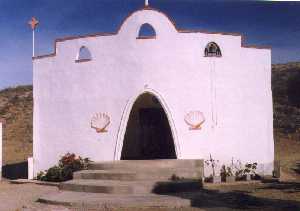
|
We hadn't filled our tanks when we got back to the Highway at Santa Maria-Jesus and the Pemex station at the Bahia Los Angeles was closed, so our next opportunity for fuel was Catavina. We got there about 15:00 to find a line of cars waiting for the Pemex station in front of La Pinta Hotel to open at 16:00. The attendant was there, in fact he filled the tank of one special friend, but there was no way he was going to interupt his siesta to fill the tanks of us tourists. So, we decided that we might as well stay in the hotel for the night. That we did. We got checked into room 123 by the swimming pool, then I went back and got the tanks filled when our friend started pumping gas at four o'clock. It was too cold for swimming so Lois and I played 8-ball on the hotel pool table instead.
We had considered taking the dirt road to San Filipe; but, after talking to a guy at the gas pumps who knew the road, I think we'll skip that drive. It's another 70 mile washboard and, from what we read of San Filipe, probably not worth the effort. We'll head on north on Highway 1 and decide later whether we want to see the Baja flatland close up.
From Rosario north we just kept rolling until we found ourselves in Ensenada. We stopped there, visited the fish market...I love that place. We had fish tacos at one of the stands there, as good as I've ever eaten. Then it was hit the road again, this time on Mexico 3 to Tacate. Shirley was sure right about that road...it's a lot more varied and scenic than the coast route. I winds over 3000 foot boulder decorated mountains and through valleys filled with vineyards. We stopped at L.A. Cetto winery, tasted some of their wines, and bought a couple of bottles of chardonnay. Got to Tacate about 14:00. The guy at the U.S. border asked if we were bringing anything back and when I said no, just waved us on. We turned east on state route 94 and almost immediately stumbled on to the Potrero County Park campground, a very pretty place where we could park under the live oak trees. They have power and water hookups and a potty dump. Just a very nice place. It seems also to be a destination location for a group of eight RVers who came in just at dusk. The kids were having fun playing skateboard games on one of the asphalt pads. They are probably here for a weekend outing.